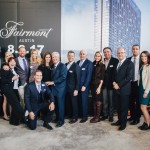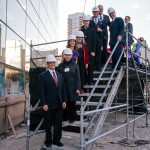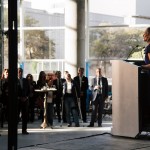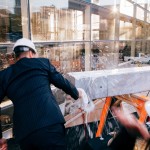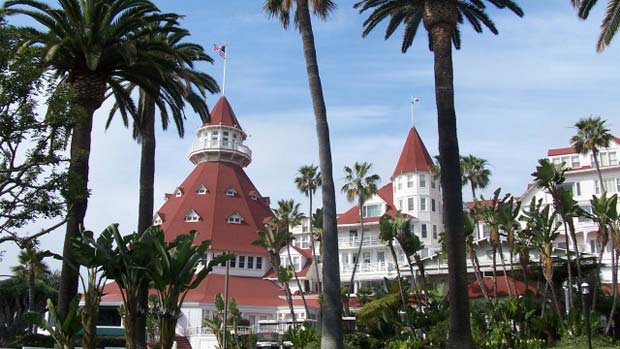Month: December 2016
Papa Doug Manchester Pledges $500,000 to Mt. Soledad Veteran’s Memorial
San Diego, CA — The Mt. Soledad Veteran’s Memorial is now a permanent monument that pays homage to veterans who have honorably served our country. In addition, the Memorial will serve to educate the public on the contributions of military personnel throughout our nation’s history.
To commemorate this special landmark, former California Gov. Pete Wilson, a U.S. Marine Corps veteran and a trustee of the National WWII Museum in New Orleans, announced a $500,000 pledge by San Diego developer Papa Doug Manchester. This formally kicks off the campaign to reimburse the $1.4 million to the Association that was used to purchase the half-acre site from the Federal Government.
This comes on the heels of the Sept. 8, 2016 ruling by the 9th U.S. Circuit Court of Appeals that brought an end to the latest round of appeals, and dismissal of the case because the central issue — a religious symbol standing on government property — was moot. The property is now privately held. This concluded the more than 25 years of lawsuits, court rulings, aborted sales and property transfers over the Mt. Soledad Cross in La Jolla, one of the longest legal battles over religious symbols on public property in the country. Responsibility for this historic landmark officially transferred to the Mt. Soledad National Veterans Memorial.
“I’m deeply honored to step forward to help assure that the Mt. Soledad Veterans Memorial stands in perpetuity for all San Diegans,” said Manchester. “I have prayed for this for many years, and have a true sense of spiritual fulfillment by supporting a memorial that honors the sacrifice of our veterans, the best and brightest amongst us.”
In addition to Manchester’s donation, the Mt. Soledad National Veterans Memorial Association noted that its campaign to support the memorial has been joined by an impressive roster of well-known San Diego philanthropists and community leaders that have pledged gifts to replenish the funds.
Major donors who have stepped forward to raise more than one and a half million dollars include former San Diego City Manager Jack McGrory, Dick Woltman, Tom and Cookie Sudberry, Dr. Peter Farrell, Kim and Marilyn Fletcher, Steve and Stephanie Williams, Jenny Craig , and Mike McKinnon. Major support has also come from the Sycuan Band of the Kumeyaay Indians.
“We are extremely pleased at the outpouring support from our community,” said Lou Scanlon, President of the Association. “The success of fund raising has exceeded our expectations; we are grateful and look forward to raising more.”
The fundraising effort, known as the, “Veterans Beacon of Freedom Campaign,” will be highlighted throughout the community on Veterans Day 2016. Those wishing to donate now, can do so by going to the Mt. Soledad Memorial Association website at www.soledadmemorial.com or calling 858-459-2314.
Papa Doug Manchester: Thoughts on Tourism in America’s Finest City
I had the good fortune and blessing to grow up in America’s Finest City in a simpler era, when San Diego County’s population was well under 1 million and there were no issues with congestion.
Interstates 5, 805, 15 and 8 did not exist. UC San Diego didn’t open until 1964. There was no Horton Plaza, Fashion Valley, Convention Center or San Diego Chargers. The Chargers came in 1961. The Padres moved from the minor leagues to the majors in 1969.
We were truly a small Navy town then and our primary industries were tuna fishing and canning. Like so many others, my family came to this region from elsewhere. We moved to Coronado from Los Angeles when my father took a job as a factory worker at Rohr Aircraft in Chula Vista. Every day he commuted down the strand through Imperial Beach because it was faster than taking the ferry to the mainland.
The Coronado Bridge didn’t open until 1969. As a kid I sold newspapers to people taking the ferry and remember that the Pacific Coast Padres used to play at Lane field at the foot of Broadway.
At that time I never in my wildest dreams conceived that someday I would build the second largest Marriott and Hyatt hotel resorts in the nation on the very spot where the ferry boats landed.
I went to high school in San Diego and earned a degree from San Diego State University. In those wonderful days, downtown San Diego was not a destination. A center-city adventure was visiting the moving sidewalk in front of the El Cortez Hotel and riding on its glass elevators on the outside of the building. It was one of the tallest structures in the area then.
Of course, we had the world-famous San Diego Zoo, iconic beaches, Balboa Park, Old Town and the Del Mar Race Track. The hotel industry was scattered, with tourists congregating around Shelter Island, the Islandia and Bali Hai Hotels in Mission Beach, and the Town and Country and Stardust in what later became the Hotel Circle area of Mission Valley.
There were many venerable visionaries who helped transform San Diego into the tourist mecca we know today. The Bahia Resort Hotel, owned by Bill Evans, was the first commercial lessee on Mission Bay, opening in early 1953 with 52 rooms after the City of San Diego offered several parcels of land for commercial development. The Evans family then acquired the right to develop land at the northwest corner of Mission Bay in 1958 for the Catamaran Resort Hotel and Spa. In April 2002 the Evans family opened the doors to The Lodge at Torrey Pines, a AAA Five Diamond resort that blends seamlessly into La Jolla’s Torrey Pines State Reserve and Torrey Pines Golf Course.
Larry Lawrence purchased a deteriorating Hotel del Coronado in 1963. Lawrence invested $150 million to refurbish and expand much of the hotel. He doubled its capacity to 700 rooms. He added the Grande Hall Convention Center and two seven-story Ocean Towers just south of the hotel.
Charles H. Brown, who is said to have once run a vegetable stand with his wife at the corner of Midway and Rosecrans and later owned a hotel on El Cajon Boulevard, opened the Town and Country Hotel in Mission Valley in 1953 with 46 rooms. Today, the 39-acre Town and Country, with 1,000 rooms and 165,000 square feet of convention and meeting space, acts as a regional convention center for Mission Valley.
The Kellogg Estate in La Jolla, which included the exclusive La Jolla Beach and Tennis Club, was purchased in 1935 by newspaperman Frederick William Kellogg. In 1940, his son William Kellogg took over management of the family’s estate. From 1940 to 1974, Kellogg directed the operations of the exclusive seaside resort with its private beach, Sea Lodge Hotel, the Playa del Oro Apartments, the F.W. Kellogg Building, 20 championship tennis courts and the well-known Marine Room restaurant.
Civic leader and real estate business executive James Colachis, a pioneer in the high-rise apartment building business, purchased the Scripps Inn in La Jolla in 1971 and the 338-room Rancho Bernardo Inn in 1975. As a civic leader he served on the board of trustees of the University of San Diego, the Independent Colleges of Southern California, the national board of the Salk Institute and the board of directors of Scripps Clinic of La Jolla.
These individuals sacrificed so much and contributed greatly to San Diego, which made my entry into the hospitality industry so much easier.
It’s stunning to think about how we’ve grown. One of our fastest growing communities, Carmel Valley, was farmland dissected by a two-lane road only 15 years ago. Highway 56 wasn’t completed until 2004. When I introduced the Grand Del Mar to the area in 2007, much of the valley was still undeveloped. The concept that a 5-star hotel and resort could prosper as a tourist mecca in the center of a residential community spoke to a new San Diego, with visitors far more mobile than ever before and willing to invest in elegance.
Today, San Diego County has a population of nearly 3.4 million and tourism is our third largest industry employing directly and indirectly almost 181,000 San Diegans. Visitors spend nearly $9.9 billion annually, which translates to a regional impact of over $16 billion new dollars generated for the regional economy. We host almost 34 million visitors each year and generate more than $704.6 million annually in state and local taxes.
We are one of the top life sciences and biotech locations in the nation and No. 1 in concentration of military/defense assets in the world. Forbes Magazine recognized San Diego as the second most inventive city in the world in 2013. UCSD is the No. 3 public university in the United States and No. 14 university in the world, according to one influential ranking. In 2015, we were the only city in North America selected by National Geographic as one of the “World’s Smart Cities.”
These remarkable distinctions bring tourists, businesses, conventions and residents to our area and economy. They bolster our hotel industry and retail establishments, support our restaurants and fill world-class attractions like the USS Midway Museum, the zoo, SeaWorld, LegoLand and the ever-magnificent Balboa Park. Our shoreline and beaches, as well as our proximity to the desert and mountains, continue to lure visitors from all over the world.
More and more people are migrating to our downtown district to live, work and play. Our bayfront, already one of the most beautiful in the world, is poised for new development along the embarcadero, Broadway with the Manchester Pacific Gateway Project, and the Seaport Village and Harbor Island redevelopments. These are all enormous economic opportunities that elevate us on the world stage and will continue to expand our tourism industry.
I’m honored to have spent my youth in San Diego and humbled to have witnessed the emergence of the region from a small town to a major world destination. I’m excited to live here now. My vision for America’s Finest City is that our waterfront and convention center will continue to grow and thrive, bringing more tourists, more businesses, more conventions, more hospitality and retail centers and, ultimately, more residents who will find San Diego as wonderfully irresistible as I do.
Article from the Times of San Diego
The Importance of Philanthropy
By Papa Doug Manchester
Recently, San Diego and our nation lost two of our most distinguished, generous, and gentle souls, Conrad Prebys and Pauline Foster. Conrad and Pauline’s wealth were far greater than dollars and cents. Their gift to all of us in San Diego was their generosity and kind spirit. They donated hundreds of millions of dollars to causes that touched their hearts, and they did so with humility and grace. Conrad and Pauline are excellent role models for the next generation of philanthropists in our community and nation.
Conrad and Pauline were both tremendous supporters of health, culture, youth and education, some of my true passions. Conrad endowed San Diego State University with a $20 million gift to create several endowed scholarships that would support at least 150 students annually. It was the single largest gift ever made to San Diego State University. Pauline was a passionate supporter of the University of California San Diego. Her $7.5 million gift in 2014 established the Pauline and Stanley Foster Pavilion for Cancer Care at Jacobs Medical Center at UC San Diego Health. Pauline also donated $5 million to establish the Stanley and Pauline Foster Endowed Chair, in honor of her late husband, at the UC San Diego Rady School of Management. She provided fellowship support for graduate students with a lead gift to the “Invent the Future” campaign, and established the Foster MBA Fellowship Fund with a $2.5 million gift.
San Diego has had the wonderful fortune of having many extraordinary individuals who have supported a wide variety of causes, from healthcare and science to the arts and education. My dear friends T. Denny Sanford, Malin Burnham, Ernie Hahn, Ernest Rady and Jenny Craig have had a magnificent impact on giving in our community. In the absence of large corporate headquarters in our region, these individuals, and others too numerous to mention, are known throughout our region for their generosity.
I had the opportunity of introducing Denny Sanford to San Diego who provided an inaugural gift for the creation of the Sanford Education Center at National University that houses the Cause Leadership Institute for nonprofit leaders and Sanford Education Programs, Sanford Harmony and Sanford Inspire. The Center’s mission is to effect positive change through the development of nonprofit leaders and teachers through the offering of inspirational and impactful programs that meet 21st century global needs. This generous gift is the first of its kind for National University. Denny has also endowed the Sanford Burnham Prebys Medical Discovery Institute and the Sanford Consortium for Regenerative Medicine.
Malin Burnham’s contributions are also impactful. He co-founded the Burnham-Moores Center for Real Estate at the University of San Diego, helped bring the USS Midway to San Diego, seeded the Burnham Institute of Medical Research, endowed UCSD and San Diego State University, and has given his time, talent and treasure to better San Diego. Malin’s motto is “community before self” and he has inspired others, including myself, to live the same.
Ernie Hahn was one of my early compatriots in shaping San Diego’s contemporary skyline. Ernie, known for developing Horton Plaza and Fashion Valley, also had a key interest in supporting education, and for many years sat on the board of the University of San Diego, where I also served for more than 30 years. Although Ernie never attended college, we shared the same beliefs in the importance of higher education as one of our most powerful tools in shaping the world. The original Ernest and Jean Hahn University Center opened in 1986 and continues today as home to the student cafeteria, faculty and staff lounge, meeting and event space and the Office of Student Affairs.
I have also had the privilege of working with Jenny and Sid Craig. In 1992, Jenny and Sid committed $10 million to the University of San Diego, $7 million of which was used to build the Jenny Craig Pavilion, a recreation and sports pavilion that was dedicated in October 2000.
As for Ernest Rady, his philanthropic contributions to this community and kind heart have been transformative. In 2004, Ernest donated $30 million to UC San Diego to start the Rady School of Management. After 10 years in existence, the school was ranked by the Financial Times as 17th best in the world for its faculty research and eighth for entrepreneurship. Its students have launched 70 startup companies that are still operating businesses. In 2014, his remarkable gift of $120 million to Rady Children’s Hospital was one of the most generous acts of philanthropy ever in San Diego and raised his total contributions to the hospital to an astounding $180 million.
A common thread between these philanthropists is the value of education as it has the ability to shape and influence generations ahead to keep our country globally competitive. My own commitments include gifts to USD, SDSU, Cathedral Catholic, Wake Forest and The Bishops School. I am most proud of the intellectual, moral and spiritual mission of USD which led me to serve as a university trustee and chair of the facilities committee that helped formulate and execute the USD master plan over a 30 year period. During this time I oversaw development of 25 of the university’s buildings and personally helped fund three: the Manchester Executive Center, The Manchester Campus Athletic Field and Dorms, and the Manchester Child Development Center.
As I reflect on the past, and think about our future, I commend the leaders who have contributed greatly to our region, and I hope that their graciousness will influence a new generation of philanthropists to emerge and move San Diego forward. The future is dependent on leaders such as these.
